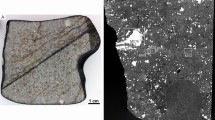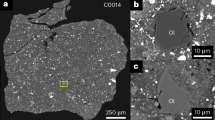Abstract
The meteorite ALH84001—a shocked igneous rock of probable martian origin—contains chemically and isotopically heterogeneous carbonate globules1–8, associated with which are organic and inorganic structures that have been interpreted7 as possible fossil remains of ancient martian biota. A critical assumption underlying this suggestion is that the carbonates formed from low-temperature fluids penetrating the cracks and voids of the host rock3. Here we report petrological studies of ALH84001 which investigate the effects of shock on the various mineralogical components of the rock. We find that carbonate, plagioclase and silica were melted and partly redistributed by the same shock event responsible for the intense local crushing1,2 of pyroxene in the meteorite. Texture and compositional data show that, during the period of shock decompression, monomineralic melts were injected into pyroxene fractures that were subsequently cooled and resealed within seconds. Our results therefore suggest that the carbonates in ALH84001 could not have formed at low temperatures, but instead crystallized from shock-melted material; this conclusion weakens significantly the arguments that these carbonates could host the fossilized remnants of biogenic activity.
This is a preview of subscription content, access via your institution
Access options
Subscribe to this journal
Receive 51 print issues and online access
$199.00 per year
only $3.90 per issue
Buy this article
- Purchase on Springer Link
- Instant access to full article PDF
Prices may be subject to local taxes which are calculated during checkout
Similar content being viewed by others
References
Mittlefehldt, D. W. ALH84001, a cumulate orthopyroxenite member of the martian meteorite clan. Meteoritics 29, 214–221 (1994).
Treiman, A. H. A petrographic history of martian meteorite ALH84001: two shocks and an ancient age. Meteoritics 30, 294–302 (1995).
Romanek, C.S. et al. Record of fluid-rock interactions on Mars from the meteorite ALH84001. Nature 372, 655–657 (1994).
Jull, A. J. T., Eastoe, C. J., Xue, S. & Herzog, G. F. Isotopic composition of carbonates in the SNC meteorites Allan Hills 84001 and Nakhla. Meteoritics 30, 311–318 (1995).
Jull, A. J. T., Eastoe, C. J. & Cloudt, S. Isotopic composition of carbonates in the SNC meteorites, Allan Hills 84001 and Zagami. J. Geophys. Res. 102, 1663–1669 (1997).
Harvey, R. P. & McSween, H. Y. Jr A possible high-temperature origin for the carbonates in the martian meteorite ALH84001. Nature 382, 49–51 (1996).
McKay, D. S. et al. Search for past life on Mars: possible relic biogenic activity in martian meteorite ALH84001. Science 273, 924–930 (1996).
Valley, J. W. et al. Low-temperature carbonate concretions in the martian meteorite ALH84001: evidence from stable isotopes and mineralogy. Science 275, 1633–1638 (1997).
Kirschvink, J. L., Maine, A. T. & Vali, H. Paleomagnetic evidence of a low-temperature origin of carbonate in the martian meteorite ALH84001. Science 275, 1629–1633 (1997).
Stöffler, D. Glasses formed by hypervelocity impact. J. Non-cryst. Solids 67, 465–502 (1984).
Thomas, K. L. et al. Microanalysis of unique fine-grained minerals in the martian meteorite ALH84001. Lunar Planet. Sci. 27, 1327–1328 (1996).
Stöffler, D. et al. Shock metamorphism and petrography of the Shergotty achondrite. Geochim. Cosmochim. Acta 50, 889–903 (1986).
Stöffler, D., Keil, K. & Scott, E. R. D. Shock metamorphism of ordinary chondrites. Geochim. Cosmochim. Acta 55, 3845–3867 (1991).
Schaal, R. B. & Hörz, F. Shock metamorphism of lunar and terrestrial basalts. Proc. Lunar Sci. Conf. 8, 1697–1729 (1977).
Rubin, A. E. A shock-metamorphic model for silicate darkening and compositionally variable plagioclase in CK and ordinary chondrites. Geochim. Cosmochim. Acta 56, 1705–1714 (1992).
Bischoff, A., Rubin, A. E., Keil, K. & Stöffler, D. Lithification of gas-rich chondrite regolith breccias by grain boundary and localized shock melting. Earth Planet. Sci. Lett. 66, 1–10 (1983).
Chen, M., Sharp, T. G., El Goresy, A., Wopenka, B. & Xie, X. The majorite-pyrope + magnesiowüstite assemblage: constraints on the history of shock veins in chondrites. Science 271, 1570–1573 (1996).
Joreau, P., Leroux, H. & Doukhan, J.-C. A transmission electron microscope investigation of shock metamorphism in olivine of the Ilafegh 013 chondrite. Meteorit. Planet. Sci. 32, 309–316 (1997).
Stöffler, D., Bischoff, A., Buchwald, V. F. & Rubin, A. E. in Meteorites and the Early Solar System (eds Kerridge, J. F. & Matthews M. S.) 165–202 (Univ. Arizona Press, Tucson, 1988).
Schmitt, R. T., Deutsch, A. & Stöffler, D. Shock recovery experiments with the H6 chondrite Kernouvé at preshock temperatures of 293 and 920 K. Meteoritics 29, 529–530 (1994).
Dobson, D. P. et al. In-situ measurement of viscosity and density of carbonate melts at high pressure. Earth Planet. Sci. Lett. 143, 207–215 (1996).
Lee, W.-J. & Wyllie, P. J. Liquid immiscibility in the join NaAlSi3O8-CaCO3 to 2.5 GPa and the origin of calciocarbonatite magmas. J. Petrol. 37, 1125–1152 (1996).
Martinez, I. et al. Shock recovery experiments on dolomite and thermodynamical calculations of impact induced decarbonation. J. Geophys. Res. 100, 15465–15476 (1995).
Lange, M. A. & Ahrens, T. J. Shock-induced CO2 loss from CaCO3; implications for early planetary atmospheres. Earth Planet. Sci. Lett. 77, 409–418 (1986).
Dence, M. R., von Engelhardt, W., Plant, A. G. & Walter, L. S. Implications of fluid immiscibility in glass from West Clearwater Lake Impact Crater, Quebec, Canada. Contrib. Mineral. Petrol. 46, 81–97 (1974).
Wyllie, P. J. in Carbonatites: Genesis and Evolution (ed. Bell, K.) 500–545 (Unwin Hyman, London, 1989).
Irving, A. J. & Wyllie, P. J. Subsolidus and melting relationships for calcite, magnesite and the join CaCO3-MgCO3 to 36kb. Geochim. Cosmochim. Acta 39, 35–53 (1975).
lonov, D. A. et al. Carbonated peridotite xenoliths from Spitzbergen: implications for trace element signature of mantle carbonate metasomatism. Earth Planet. Sci. Lett. 119, 283–297 (1993).
Wright, I. P., Grady, M. M. & Pillinger, C. T. Organic materials in a martian meteorite. Nature 340, 220–222 (1989).
Semenenko, V. P. & Golovka, N. V. Shock-induced black veins and organic compounds in ordinary chondrites. Geochim. Cosmochim. Acta 58, 1525–1535 (1994).
Author information
Authors and Affiliations
Rights and permissions
About this article
Cite this article
Scott, E., Yamaguchi, A. & Krot, A. Petrological evidence for shock melting of carbonates in the martian meteorite ALH84001. Nature 387, 377–379 (1997). https://doi.org/10.1038/387377a0
Received:
Accepted:
Issue Date:
DOI: https://doi.org/10.1038/387377a0
This article is cited by
-
No ‘nanofossils’ in martian meteorite
Nature (1997)
-
No ‘nanofossils’ in martian meteorite
Nature (1997)
Comments
By submitting a comment you agree to abide by our Terms and Community Guidelines. If you find something abusive or that does not comply with our terms or guidelines please flag it as inappropriate.



